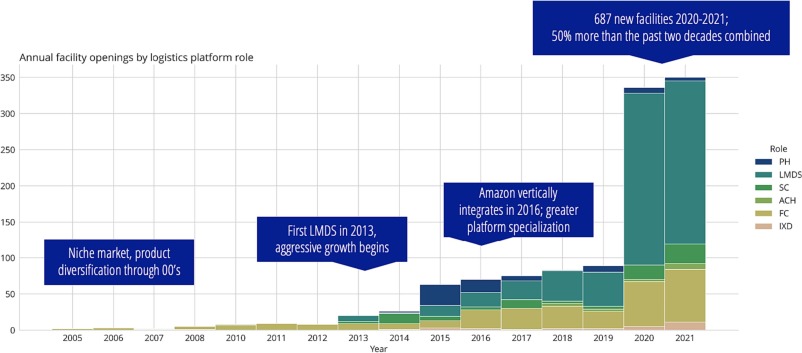The rise of e-commerce helped fuel consumer appetite for quick home deliveries. One consequence has been the placing of some logistics facilities in proximity to denser consumer markets. The trend departs from the prevailing discussion on “logistics sprawl,” or the proliferation of warehousing into the urban periphery. A recent study by Fried and Goodchild spatially and statistically explored the facility- and region-level dimensions that characterize the centrality of e-commerce logistics platforms.
Analyzing 910 operational Amazon logistics platforms in 89 US metropolitan statistical areas (MSAs) between 2013 and 2021, the study estimates temporal changes in distances to relative population centroids and population-weighted market densities.

This study presents a first effort to reveal spatial nuance in e-commerce platform siting decisions around U.S. metropolitan areas. The study hones in on Amazon’s recent build-out of last-mile delivery stations, which differ from conventional distribution centers’ ability to serve home delivery more expediently. Namely, these facilities have moved moderately closer to consumer households, forgoing the larger floorspace and lower rents that suburban locations accommodate—sometimes.
More recently, LMDS has shown signs of decentralization matching the spatial trends of more upstream logistics facilities and W&D spaces, more generally indicative of a new phase in Amazon’s horizontal integration to smaller markets. Robichet et al. (2021) also show in their analysis of microhub allocation in Paris that high real estate prices can eventually render urban siting unattractive as platforms near the city core become more saturated.
Amazon’s newness limits this study’s temporal scope, and this study does not attempt to make long-term projections regarding future e-commerce platform localization. Moreover, while this study measures the extent of e-commerce logistics (de)centralization, it does not causally explain why Amazon is sprawling in some cities and centralizing in others. However, the results present implications extending beyond any one e-commerce platform.
The observed spatial trends reflect the restructuring of retail and logistics spaces, generating heightened commercial competition for real estate, curb, and street access in the urban core, leading to a supposed “space race” for freight carriers. But this has not been at the expense of e-commerce’s sprawling logistical footprint in the exurbs. The analysis reveals a heterogeneity of cases across facility types and cities, which future studies can and should explore.
